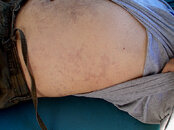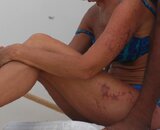It seemed to me that the rash was pink and not the distinct blue-purple associated with cutis marmorata. Also this discoloration is usually found in the fatty tissue, which the OP stated that it wasn't (post 6). The rashes dispersed relatively quickly without treatment.
I had agreed with you that it was prudent for her to seek a medical diagnosis. Obviously, I'm not a Hyperbaric Physician, nor do I practice medicine. If I did, I wouldn't depend upon making a diagnosis utilizing two Internet based photos.

It is important for people to seek treatment, if they are in-doubt. I suppose because I've experienced "itches" and "rashes" a few times myself and these have been dismissed by Hyperbaric Physicians, if they are experienced and are not accompanied by neurological or musculoskeletal symptoms, I can dismiss them as well (but try to learn from the experience). As I've mentioned, this is usual practice for professional divers.





